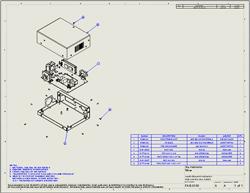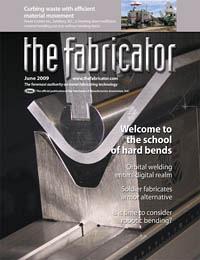Contributing Writer
- FMA
- The Fabricator
- FABTECH
- Canadian Metalworking
Categories
- Additive Manufacturing
- Aluminum Welding
- Arc Welding
- Assembly and Joining
- Automation and Robotics
- Bending and Forming
- Consumables
- Cutting and Weld Prep
- Electric Vehicles
- En Español
- Finishing
- Hydroforming
- Laser Cutting
- Laser Welding
- Machining
- Manufacturing Software
- Materials Handling
- Metals/Materials
- Oxyfuel Cutting
- Plasma Cutting
- Power Tools
- Punching and Other Holemaking
- Roll Forming
- Safety
- Sawing
- Shearing
- Shop Management
- Testing and Measuring
- Tube and Pipe Fabrication
- Tube and Pipe Production
- Waterjet Cutting
Industry Directory
Webcasts
Podcasts
FAB 40
Advertise
Subscribe
Account Login
Search
The most important output of 3-D CAD modeling
Techniques to consider when modeling components in for a design project
- By Gerald Davis
- June 1, 2009
- Article
- Shop Management
I recently attended a very interesting presentation by Chris Naujok, an engineer who is a SolidWorks® guru. One of the first questions he asked his audience of CAD jockeys was this: What is the most important thing you produce?
The shouted responses included "drawings," "great designs," "great products," and "cost reductions." He agreed that all of those are important, but the most important output from our CAD systems is a bill of materials (BOM).
The BOM may seem mundane, but it is what makes purchasing, accounting, and manufacturing happen. Without it, there isn't much point to CAD modeling. An example of a drawing with a BOM is shown in Figure 1.
BOMs Away
So why not just fire up a spreadsheet and prepare a BOM like the one shown in Figure 2? Why mess with the 3-D CAD system at all? If the spreadsheet will convey what the product looks like, how the parts fit together, and how the parts will be obtained, then the answer is "no CAD required."
With the BOM as the goal, then, we know a lot about how to model our project. We need to complete the project quickly, which is a given; modeling efficiently is something we always strive for. We also know that the parts have to fit together; if the holes don't align, we will be maligned. Other automatic goals are to have it look great and to make the design suitable for manufacturing.
Minimalist Mentality
The two kinds of objects in the world are things that are purchased and things that are made. Over the years I have observed that many folks who were just starting out in the 3-D CAD business spent an inordinate amount of time putting perfect detail into every component.
Figure 3 is an example of a fan that is purchased. The model includes a properly shaped propeller that even rotates!
For those components in our product that are purchased, we probably don't need to model anything beyond the features that influence the parts that we will have custom-made. Figure 4 shows the frame of the fan. We can use it to locate the mounting holes and airflow cutout. We don't really need the propeller if all we're doing is modeling the sheet metal chassis.
Of course, if we are manufacturing nuts and bolts, then modeling the threads and grade marks would be very important. If we're just including the fasteners in our model in order to generate a complete BOM, then just a representative shape will probably do the job.
Sometimes occasions arise when realism is vital. I've made presentations of a design concept that featured the minimalist approach as well as presentations based on models that were ridiculously detailed. In nearly every case, my design was more favorably received when the presentation appeared more realistic. The exceptions were those individuals who knew how much the extraneous detail added to the time and cost of my presentation.
Figure 5 shows a model that has quite a bit of detail in the electronics. The goal was to design the sheet metal enclosure, so all of the work that I put into modeling the legs on the IC chips seemed frivolous. However, during the presentation, one of the electrical engineers used that detail to make an important point about the project. It is hard to predict how much is too much.
Lazy or Clever?
A lazy CAD jockey will model the parts so that the production of the mechanical drawing for manufacturing is nearly automatic. This is accomplished by dimensioning the modeling sketches so that they can be imported directly into the drafting work. If you can anticipate that far in advance, then modeling your part that way can save some serious effort.
Next month we'll take a closer look at generating drawings for manufacturing. It isn't fully automatic, but there are techniques that can bring joy into the drafting of prints.
Gerald would love to have you send him your comments and questions. You are not alone, and the problems you face often are shared by others. Share the grief, and perhaps we will all share in the joy of finding answers. Please send your questions and comments to dand@thefabricator.com.
About the Author
subscribe now

The Fabricator is North America's leading magazine for the metal forming and fabricating industry. The magazine delivers the news, technical articles, and case histories that enable fabricators to do their jobs more efficiently. The Fabricator has served the industry since 1970.
start your free subscription- Stay connected from anywhere

Easily access valuable industry resources now with full access to the digital edition of The Fabricator.

Easily access valuable industry resources now with full access to the digital edition of The Welder.

Easily access valuable industry resources now with full access to the digital edition of The Tube and Pipe Journal.
- Podcasting
- Podcast:
- The Fabricator Podcast
- Published:
- 04/16/2024
- Running Time:
- 63:29
In this episode of The Fabricator Podcast, Caleb Chamberlain, co-founder and CEO of OSH Cut, discusses his company’s...
- Trending Articles
Steel industry reacts to Nucor’s new weekly published HRC price

How to set a press brake backgauge manually

Capturing, recording equipment inspection data for FMEA

Are two heads better than one in fiber laser cutting?

Hypertherm Associates implements Rapyuta Robotics AMRs in warehouse

- Industry Events
16th Annual Safety Conference
- April 30 - May 1, 2024
- Elgin,
Pipe and Tube Conference
- May 21 - 22, 2024
- Omaha, NE
World-Class Roll Forming Workshop
- June 5 - 6, 2024
- Louisville, KY
Advanced Laser Application Workshop
- June 25 - 27, 2024
- Novi, MI




























